In
our pilot research, we draped a slim, versatile electrode array over the surface area of the volunteer’s brain. The electrodes recorded neural signals and sent them to a speech decoder, which translated the alerts into the words the guy supposed to say. It was the to start with time a paralyzed man or woman who could not converse had employed neurotechnology to broadcast entire words—not just letters—from the brain.
That trial was the end result of much more than a decade of investigate on the fundamental brain mechanisms that govern speech, and we’re enormously happy of what we have accomplished so far. But we’re just obtaining begun.
My lab at UCSF is operating with colleagues close to the earth to make this technological innovation secure, secure, and trusted plenty of for day-to-day use at house. We’re also functioning to improve the system’s performance so it will be well worth the energy.
How neuroprosthetics operate
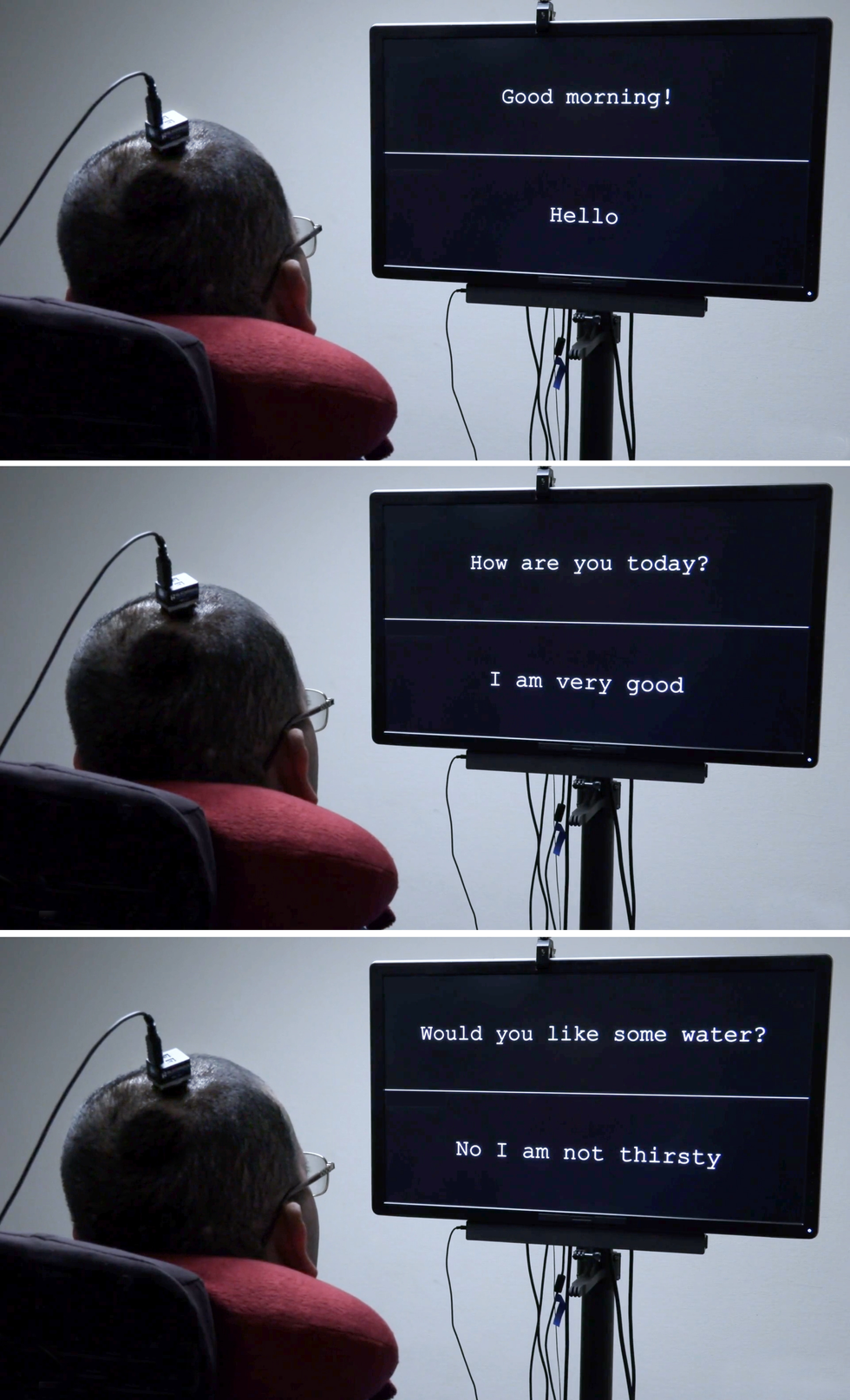 The to start with version of the brain-personal computer interface gave the volunteer a vocabulary of 50 simple phrases. College of California, San Francisco
The to start with version of the brain-personal computer interface gave the volunteer a vocabulary of 50 simple phrases. College of California, San Francisco
Neuroprosthetics have arrive a extended way in the previous two a long time. Prosthetic implants for listening to have advanced the furthest, with designs that interface with the
cochlear nerve of the interior ear or straight into the auditory mind stem. There is also considerable investigate on retinal and brain implants for eyesight, as effectively as efforts to give people with prosthetic hands a sense of touch. All of these sensory prosthetics choose facts from the exterior environment and transform it into electrical alerts that feed into the brain’s processing centers.
The reverse kind of neuroprosthetic information the electrical action of the brain and converts it into indicators that handle something in the outside the house globe, these types of as a
robotic arm, a movie-match controller, or a cursor on a laptop or computer display. That final command modality has been made use of by teams such as the BrainGate consortium to empower paralyzed people to style words—sometimes a person letter at a time, at times utilizing an autocomplete purpose to speed up the course of action.
For that typing-by-mind operate, an implant is commonly positioned in the motor cortex, the component of the brain that controls movement. Then the person imagines sure actual physical steps to handle a cursor that moves around a virtual keyboard. Another method, pioneered by some of my collaborators in a
2021 paper, experienced a single person envision that he was holding a pen to paper and was composing letters, generating alerts in the motor cortex that ended up translated into text. That tactic established a new report for pace, enabling the volunteer to produce about 18 phrases for each minute.
In my lab’s study, we have taken a much more ambitious approach. Alternatively of decoding a user’s intent to move a cursor or a pen, we decode the intent to control the vocal tract, comprising dozens of muscle groups governing the larynx (frequently known as the voice box), the tongue, and the lips.
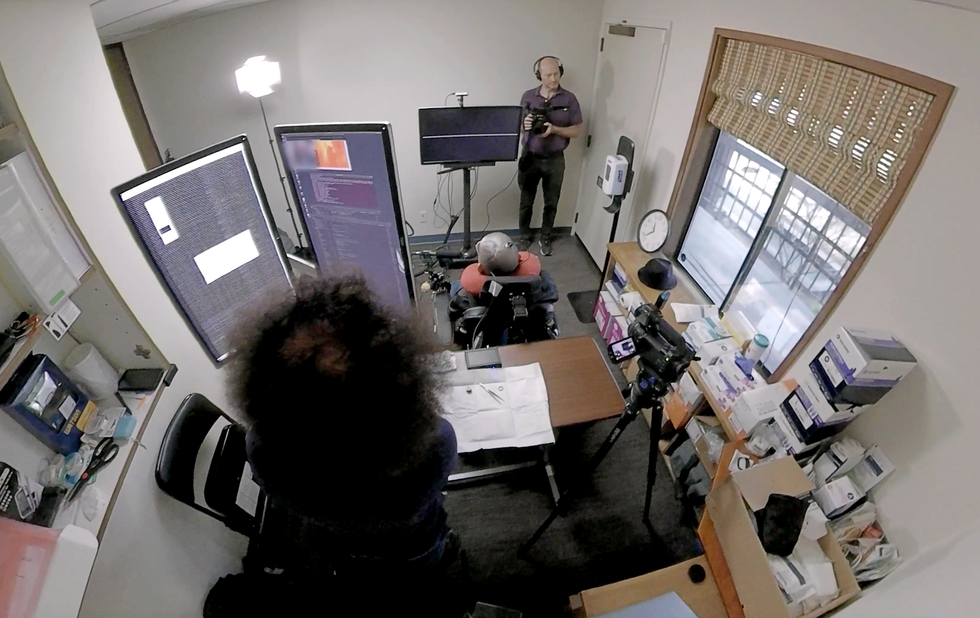 The seemingly simple conversational set up for the paralyzed man [in pink shirt] is enabled by both equally refined neurotech hardware and equipment-discovering programs that decode his brain indicators. University of California, San Francisco
The seemingly simple conversational set up for the paralyzed man [in pink shirt] is enabled by both equally refined neurotech hardware and equipment-discovering programs that decode his brain indicators. University of California, San Francisco
I began operating in this place a lot more than 10 several years back. As a neurosurgeon, I would frequently see people with serious injuries that remaining them not able to talk. To my shock, in a lot of circumstances the destinations of mind accidents didn’t match up with the syndromes I uncovered about in health care school, and I realized that we continue to have a good deal to master about how language is processed in the brain. I decided to study the fundamental neurobiology of language and, if attainable, to build a brain-machine interface (BMI) to restore conversation for people who have lost it. In addition to my neurosurgical background, my workforce has expertise in linguistics, electrical engineering, laptop or computer science, bioengineering, and medicine. Our ongoing scientific demo is tests both of those hardware and computer software to explore the limits of our BMI and establish what form of speech we can restore to men and women.
The muscle tissue included in speech
Speech is a single of the behaviors that
sets individuals apart. Lots of other species vocalize, but only individuals mix a set of seems in myriad diverse ways to represent the environment all-around them. It’s also an terribly complicated motor act—some experts feel it’s the most intricate motor motion that people today complete. Speaking is a merchandise of modulated air stream via the vocal tract with each utterance we shape the breath by producing audible vibrations in our laryngeal vocal folds and changing the shape of the lips, jaw, and tongue.
Quite a few of the muscle tissues of the vocal tract are pretty compared with the joint-dependent muscles this sort of as all those in the arms and legs, which can transfer in only a couple approved techniques. For example, the muscle mass that controls the lips is a sphincter, even though the muscle groups that make up the tongue are governed extra by hydraulics—the tongue is mostly composed of a set volume of muscular tissue, so relocating a person section of the tongue variations its form somewhere else. The physics governing the movements of this kind of muscle tissue is totally unique from that of the biceps or hamstrings.
Mainly because there are so many muscles associated and they just about every have so a lot of levels of freedom, there is essentially an infinite range of attainable configurations. But when individuals discuss, it turns out they use a fairly modest set of main movements (which vary rather in different languages). For instance, when English speakers make the “d” sound, they put their tongues guiding their teeth when they make the “k” seem, the backs of their tongues go up to contact the ceiling of the back of the mouth. Several persons are conscious of the exact, elaborate, and coordinated muscle actions demanded to say the easiest term.
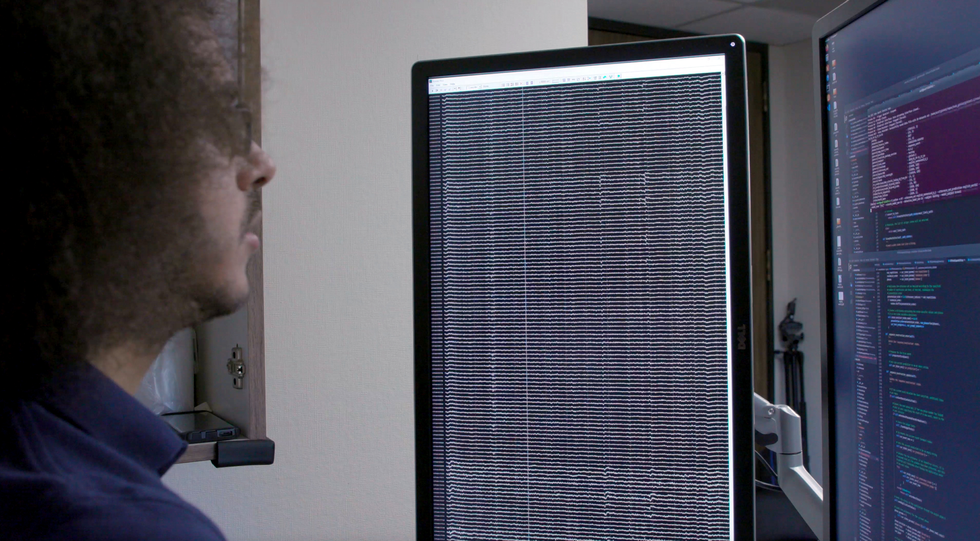 Workforce member David Moses seems to be at a readout of the patient’s brain waves [left screen] and a show of the decoding system’s activity [right screen].College of California, San Francisco
Workforce member David Moses seems to be at a readout of the patient’s brain waves [left screen] and a show of the decoding system’s activity [right screen].College of California, San Francisco
My exploration team focuses on the pieces of the brain’s motor cortex that deliver motion instructions to the muscular tissues of the deal with, throat, mouth, and tongue. Those people brain locations are multitaskers: They handle muscle movements that make speech and also the actions of those people exact same muscle tissues for swallowing, smiling, and kissing.
Finding out the neural activity of these areas in a beneficial way calls for both equally spatial resolution on the scale of millimeters and temporal resolution on the scale of milliseconds. Historically, noninvasive imaging programs have been ready to deliver a single or the other, but not both equally. When we started this analysis, we located remarkably tiny details on how mind exercise styles ended up affiliated with even the most basic elements of speech: phonemes and syllables.
Below we owe a credit card debt of gratitude to our volunteers. At the UCSF epilepsy center, clients making ready for surgical procedures usually have electrodes surgically placed about the surfaces of their brains for quite a few times so we can map the locations associated when they have seizures. Through those people handful of days of wired-up downtime, a lot of sufferers volunteer for neurological study experiments that make use of the electrode recordings from their brains. My team requested sufferers to allow us examine their styles of neural action whilst they spoke words.
The hardware involved is called
electrocorticography (ECoG). The electrodes in an ECoG program really don’t penetrate the mind but lie on the surface of it. Our arrays can contain a number of hundred electrode sensors, each of which documents from hundreds of neurons. So much, we have utilized an array with 256 channels. Our intention in all those early scientific studies was to uncover the designs of cortical exercise when individuals converse very simple syllables. We asked volunteers to say certain appears and words when we recorded their neural designs and tracked the movements of their tongues and mouths. Occasionally we did so by obtaining them use coloured deal with paint and applying a computer system-vision system to extract the kinematic gestures other occasions we utilized an ultrasound equipment positioned less than the patients’ jaws to picture their shifting tongues.
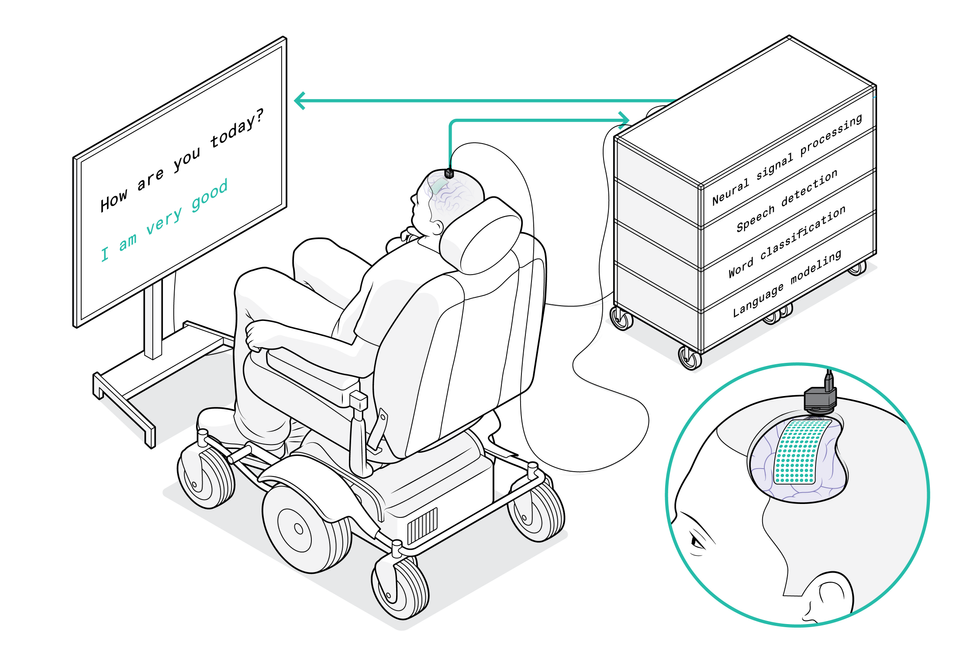 The system begins with a versatile electrode array that’s draped above the patient’s brain to choose up signals from the motor cortex. The array particularly captures movement commands meant for the patient’s vocal tract. A port affixed to the skull guides the wires that go to the computer method, which decodes the brain alerts and translates them into the words and phrases that the client wants to say. His answers then surface on the screen display screen.Chris Philpot
The system begins with a versatile electrode array that’s draped above the patient’s brain to choose up signals from the motor cortex. The array particularly captures movement commands meant for the patient’s vocal tract. A port affixed to the skull guides the wires that go to the computer method, which decodes the brain alerts and translates them into the words and phrases that the client wants to say. His answers then surface on the screen display screen.Chris Philpot
We made use of these systems to match neural patterns to actions of the vocal tract. At very first we had a lot of questions about the neural code. Just one risk was that neural action encoded instructions for individual muscles, and the mind essentially turned these muscular tissues on and off as if urgent keys on a keyboard. Yet another thought was that the code established the velocity of the muscle contractions. Nevertheless a different was that neural action corresponded with coordinated designs of muscle contractions used to develop a particular seem. (For case in point, to make the “aaah” seem, the two the tongue and the jaw have to have to fall.) What we identified was that there is a map of representations that controls distinct parts of the vocal tract, and that alongside one another the diverse brain areas merge in a coordinated fashion to give rise to fluent speech.
The purpose of AI in today’s neurotech
Our work relies upon on the advances in synthetic intelligence about the past ten years. We can feed the knowledge we collected about each neural action and the kinematics of speech into a neural community, then enable the device-understanding algorithm find styles in the associations between the two details sets. It was feasible to make connections involving neural activity and developed speech, and to use this product to develop laptop or computer-produced speech or textual content. But this system could not coach an algorithm for paralyzed people mainly because we’d lack 50 % of the knowledge: We’d have the neural patterns, but nothing at all about the corresponding muscle mass actions.
The smarter way to use machine understanding, we realized, was to crack the difficulty into two steps. Initially, the decoder translates indicators from the brain into intended movements of muscles in the vocal tract, then it interprets these supposed actions into synthesized speech or text.
We contact this a biomimetic solution due to the fact it copies biology in the human physique, neural exercise is directly responsible for the vocal tract’s actions and is only indirectly dependable for the seems generated. A significant edge of this solution arrives in the training of the decoder for that next action of translating muscle mass actions into sounds. Since these relationships concerning vocal tract actions and seem are relatively common, we have been equipped to prepare the decoder on massive data sets derived from people today who weren’t paralyzed.
A clinical demo to check our speech neuroprosthetic
The up coming major obstacle was to provide the know-how to the folks who could really benefit from it.
The Nationwide Institutes of Wellness (NIH) is funding
our pilot trial, which began in 2021. We currently have two paralyzed volunteers with implanted ECoG arrays, and we hope to enroll much more in the coming yrs. The key objective is to boost their interaction, and we’re measuring performance in terms of text for each minute. An typical grownup typing on a full keyboard can sort 40 words and phrases for every minute, with the fastest typists achieving speeds of extra than 80 words per moment.
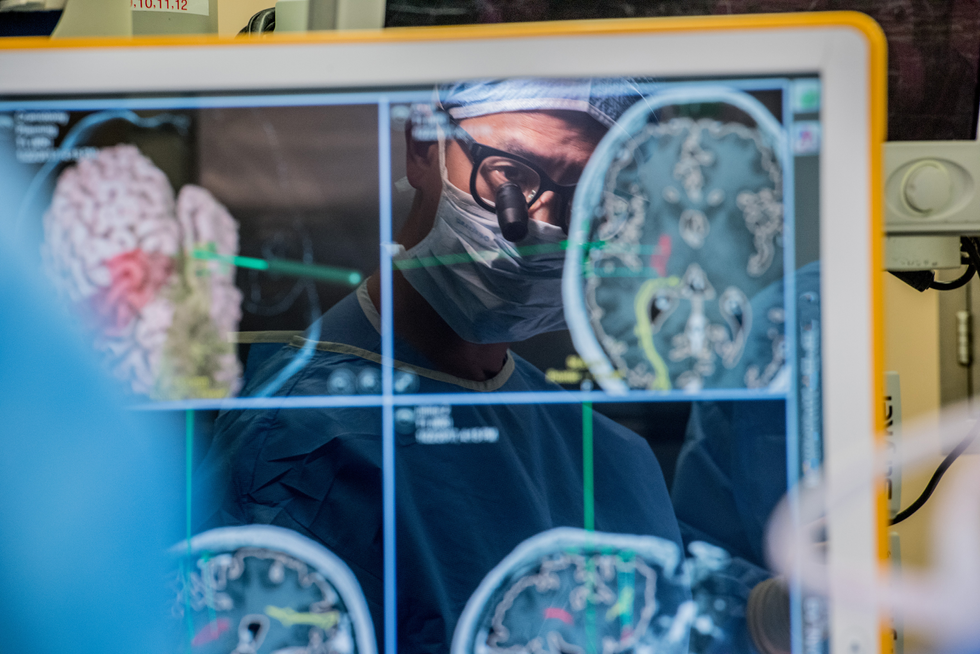 Edward Chang was encouraged to develop a mind-to-speech system by the patients he encountered in his neurosurgery observe. Barbara Ries
Edward Chang was encouraged to develop a mind-to-speech system by the patients he encountered in his neurosurgery observe. Barbara Ries
We imagine that tapping into the speech system can deliver even much better results. Human speech is significantly faster than typing: An English speaker can simply say 150 phrases in a minute. We’d like to permit paralyzed persons to connect at a amount of 100 text for each minute. We have a ton of get the job done to do to achieve that objective, but we feel our approach would make it a feasible target.
The implant course of action is routine. To start with the surgeon gets rid of a small portion of the skull next, the adaptable ECoG array is carefully put throughout the floor of the cortex. Then a modest port is fixed to the skull bone and exits through a individual opening in the scalp. We now have to have that port, which attaches to external wires to transmit facts from the electrodes, but we hope to make the procedure wireless in the future.
We have regarded as employing penetrating microelectrodes, since they can file from smaller sized neural populations and may as a result deliver extra element about neural exercise. But the existing hardware is not as sturdy and risk-free as ECoG for scientific purposes, especially more than quite a few many years.
Another thought is that penetrating electrodes normally demand each day recalibration to transform the neural alerts into clear instructions, and study on neural gadgets has proven that velocity of setup and overall performance reliability are key to acquiring men and women to use the technological know-how. Which is why we’ve prioritized balance in
making a “plug and play” technique for extended-expression use. We conducted a review on the lookout at the variability of a volunteer’s neural indicators above time and observed that the decoder done greater if it utilised info designs across a number of sessions and various days. In machine-finding out phrases, we say that the decoder’s “weights” carried over, producing consolidated neural alerts.
https://www.youtube.com/look at?v=AfX-fH3A6BsCollege of California, San Francisco
Since our paralyzed volunteers just cannot discuss though we observe their mind designs, we questioned our initial volunteer to consider two unique approaches. He started off with a list of 50 text that are helpful for everyday life, these kinds of as “hungry,” “thirsty,” “please,” “help,” and “computer.” All through 48 sessions over quite a few months, we sometimes requested him to just picture expressing each individual of the text on the list, and at times requested him to overtly
attempt to say them. We uncovered that tries to communicate produced clearer mind indicators and were being adequate to teach the decoding algorithm. Then the volunteer could use those people words and phrases from the list to crank out sentences of his have deciding on, this sort of as “No I am not thirsty.”
We’re now pushing to extend to a broader vocabulary. To make that get the job done, we need to carry on to strengthen the present algorithms and interfaces, but I am self-confident those enhancements will take place in the coming months and years. Now that the proof of basic principle has been established, the purpose is optimization. We can emphasis on earning our program more rapidly, more exact, and—most important— safer and more trustworthy. Items must shift immediately now.
Possibly the largest breakthroughs will appear if we can get a superior being familiar with of the brain programs we’re seeking to decode, and how paralysis alters their exercise. We have appear to comprehend that the neural designs of a paralyzed individual who just can’t deliver instructions to the muscle tissues of their vocal tract are incredibly diverse from all those of an epilepsy affected person who can. We’re attempting an formidable feat of BMI engineering when there is continue to heaps to learn about the fundamental neuroscience. We consider it will all come collectively to give our clients their voices back again.
From Your Web-site Posts
Similar Posts Around the Net





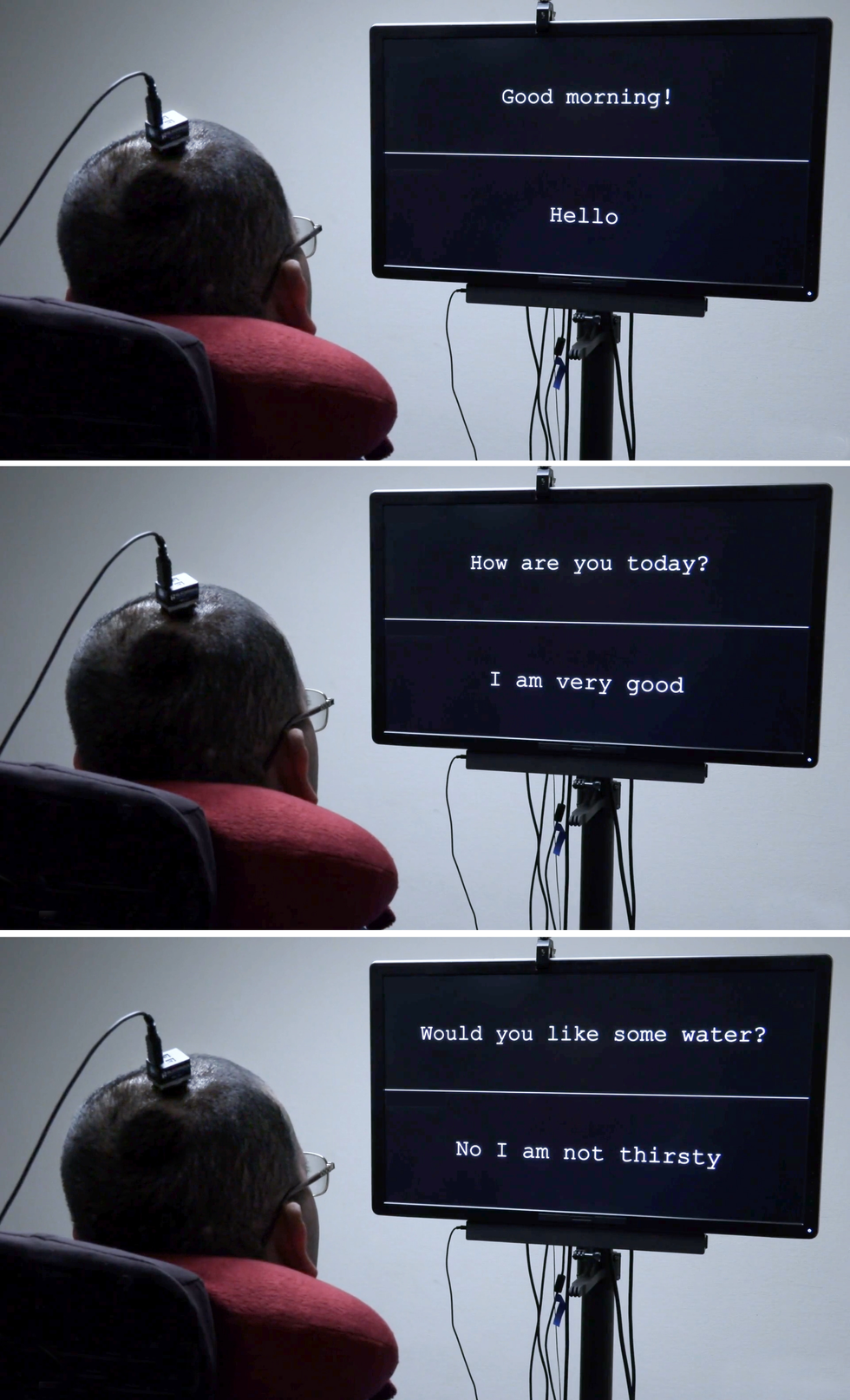
More Stories
Domain Knowledge of a Successful Medical Writer
Evaluation of Knowledge Based Training Programs Using Repertory Grid
Sharing My Knowledge on Vedanta – Nature of the Self (Atman)